#Fred Kohlmar
Explore tagged Tumblr posts
Photo


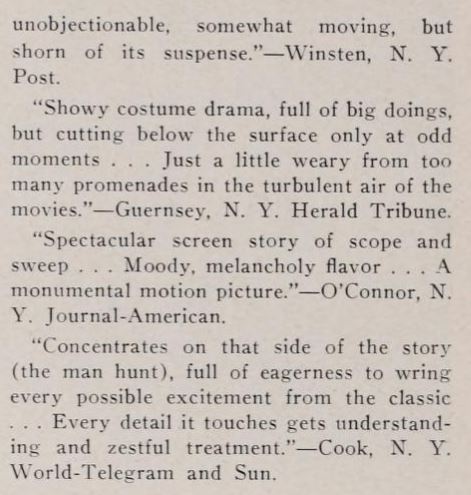
A remake of Victor Hugo's immortal classic about the relentless pursuit of a man by the law, this latest film version of "Les Miserables" has some moments of high excitement and suspense, but, on the whole, it falls short of being the solid, marketable product needed for today's fickle boxoffices.
The Fred Kohlmar production has all the appearances of a great motion picture, for it boasts a superb cast, authentic settings and some astute direction, but its weakness lies in Richard Murphy's screenplay which has failed to capture the tragic overtones and stark drama of Hugo's original story. After the early scenes, which are hard hitting, forceful sequences, the film lapses into a plethora of talk and emotional ramblings from which it never wholly emerges. The result of this is a film that will probably do its best business in art houses, or nabes-hoods and first-runs catering to class audiences. It will be a fairly strong attraction for action houses, too, but family spots will find it difficult to sell.
Director Lewis Milestone has guided his players with many adept touches, but has been unable to maintain the fast pace of opening sequences and has been hindered by the slow-moving screenplay in later scenes. The cast labors under the same difficulties, but some notable performances do emerge as Michael Rennie portrays the hero Jean Valjean in a warm, convincing manner and Robert Newton effectively personifies the law in his role of Javert. The supporting cast headed by Edmund Gwenn, Debra Paget and Cameron Mitchell is effective with no poor performances to be found.
Source: The Film Bulletin, 1952
2 notes
·
View notes
Text

200 Films of 1952
Film number 189: Les Miserables
Release date: August 14th, 1952
Studio: 20th Century Fox
Genre: drama
Director: Lewis Milestone
Producer: Fred Kohlmar
Actors: Michael Rennie, Debra Paget, Robert Newton, Edmund Gwenn, Cameron Mitchell
Plot Summary: Based on the epic Victor Hugo novel, we see Jean Valjean sent to prison for stealing a loaf of bread. Meeting a kindly bishop who helps him get on his feet after his release, Valjean tries to do good in the world. He breaks his parole, however, and a malevolent French Inspector named Javert becomes obsessed with catching him.
My Rating (out of five stars): ***¾
I’ve never seen the 1935 Hollywood version of this film, which everyone seems to agree is far superior to this. Without that lens to view it through, I thought this 1952 version was pretty good- not great exactly, but quite good. There are a few performances in it that make it worth watching, and Lewis Milestone’s direction was visually striking.
The Good:
Robert Newton as Javert. He was the best part of the film for me. He played the role with a creepy, imposing, desperately obsessive edge, which was exactly what was required.
Javert the character. One of the great characters in literature, his obsessive drive for a machine-like “justice” combined with his traumatic past creates some damn good complexity.
Michael Rennie as Valjean. Rennie will forever be the regal alien in The Day the Earth Stood Still for me, and I love him for it. Here he played Valjean with a lot of sympathy, conveying much through his eyes and expressions.
Edmund Gwenn as the Bishop. Who can ever resist the charms of this man?
Cameron Mitchell as Marius. He played an idealistic revolutionary well.
The direction by Milestone. It was a very interesting film from a visual standpoint. The close-ups were used well, and there were a lot of cool shot compositions. It was also the ideal kind of situation where things were distinctive and creative, but it didn’t pull you out of the movie.
I thought the film did a good job compressing a longer story into a shorter period of time.
The courtroom scenes were particularly visually arresting (pun!)- with a truly nightmarish feel. I’m sure they were influenced by the devastating 1928 French film The Passion of Joan of Arc, because I couldn’t help but think of it.
The political and philosophical messages were conveyed without hitting you over the head with it.
The line by Robert near the end to Javert: “How does success taste after all these years?” Chills!
The Bad:
Rennie was good, but maybe a little too restrained?
Debra Paget as Cosette. Most of the blame can probably go to the script and the Hollywood portrayal of these kinds of roles at the time. She overacted, falling into that “innocent damsel” stereotype.
Debra Paget’s makeup. How she could have been in a mid 19th century convent school with that kind of makeup on her face is laughable.
All the talk of a high school girl being “a desirable woman” ready for marriage. Yes, it was historically accurate to the 19th century, but it was still super gross watching it now.
The hint of incest also grossed me out. I know Valjean was only Cosette’s non-genetic guardian, but she constantly called him father. It’s not technically incest, but... eew.
The use of the intertitles that came on the screen as chapter dividers was inane and totally unnecessary.
I don’t know that this is bad per se, but I find it funny that Hollywood favors using English actors to play European roles, especially if they are larger protagonist roles. I could list examples, but we’d be here forever. It’s just weird to me, because why don’t you ask an English person how French or German they feel...
0 notes
Photo

Kiss of Death (1947)
When 20th Century Fox put together the pieces to launch a production of film noir Kiss of Death, the picture was to be a vehicle for leading man Victor Mature. Mature had impressed Fox’s chief executive, Darryl F. Zanuck, in a supporting performance as Doc Holliday in My Darling Clementine (1946). Zanuck wished to reward the Fox contractee with a starring role, buying the rights to the film’s story with Mature in mind. But no one at Fox expected what would happen next: an actor debuting in his first film role would overshadow Mature. Kiss of Death marks the cinematic debut for Richard Widmark, best-known at the time for his Broadway work in pleasant, romantic comedy roles. For his first movie appearance, Widmark – and I don’t write something like this lightly – provides one of the most terrifying debuts in film history. This is not to downplay the performances (of Mature, Brian Donlevy, or fellow debutant Coleen Gray) or the filmmaking, but Widmark’s performance alone make Kiss of Death – directed by Henry Hathaway, from a screenplay by Ben Hecht and Charles Lederer – an essential film noir.
After a failed jewelry store robbery on Christmas Eve, ex-con Nick Bianco (Victor Mature) is offered leniency from New York City Assistant District Attorney Louis D’Angelo (Brian Donlevy) if Nick can provide the names of his accomplices to the robbery. Against all common sense and in the belief his accomplices will take care of his wife and daughters, Nick refuses. He is handed a twenty-year sentence in Sing Sing. Several months into the sentence, he learns that his wife has committed suicide following a rape by one of his accomplices* and that his daughters have been handed over to an orphanage. Former babysitter Nettie Cavallo (Coleen Gray) divulges this news to Nick, who then indicates his desire to cooperate with the ADA. In an arrangement agreed to by D’Angelo and Nick’s lawyer, Earl Howser (Taylor Holmes), Nick becomes a jailhouse informant and is given the possibility of an earlier parole. While serving as a jailhouse informant, he will encounter Tommy Udo (Widmark) – who, eventually, uses any means at his disposal to keep Nick silent about his plans and partners-in-crime.
The film also stars Mildred Dunnock (appearing briefly in one of the most memorable scenes in any film noir), character actors Howard Smith and Millard Mitchell, and only the second credited film for eventual star Karl Malden.
Before commenting on how the performances heighten what could have been your run-of-the-mill film noir, Norbert Brodine’s (1938’s Merrily We Live, 1949’s Thieves’ Highway) cinematography and J. Watson Webb Jr.’s (1944’s The Lodger, 1952’s With a Song in My Heart) editing are superb. One only has to watch the opening moments of the film to witness the benefits of their collaboration. The failed robbery scene is a textbook example of economical filmmaking. Webb’s cutting neither lingers nor moves away too rapidly for the audience’s comprehension. Brodine’s strategic placements of his camera and use of blocking – of Mature, the supporting actors, extras, and the production design – ratchets up the tension, suggesting without any words how little room for error there is in this operation. Small details such as what level an elevator is on allow the audience to agonize – however much we do not want to see this robbery succeed – over the robbers’ wasted seconds. In Kiss of Death’s tensest scenes, this mercurial combination splices into moments that will shock and unnerve. Kiss of Death is an ideal counterargument to black-and-white film’s uninformed naysayers but, more compellingly, an entry point for film noir novices.
When complemented with Richard Widmark’s performance, Kiss of Death becomes horrifying. Widmark’s face often sports a toothy half-grin that only serves to intimidate. To make matters worse, as Tommy Udo, his staccato snigger accompanies a grin belying a man unhinged, delighting in his sadistic and psychopathic ways. Udo’s disconcerting voice and manner of speech reveals a character as slippery as a soapy eel. The way he tells a cop prodding for information that, “I wouldn’t give you the skin off a grape,” comes laced with dismissal, menace, and even playfulness.
It is difficult to watch the harm Tommy Udo brings to others. But Widmark is so convincing in the role, it is impossible to keep one’s eyes off of him. If you are aware about the basics of the Hays Code, you can easily guess Tommy Udo’s fate. But beyond the scope of the film’s narrative, the character inspired certain men in American colleges and universities to form Tommy Udo clubs or fraternities. These clubs and fraternities codified Udo’s disgusting male chauvinism – as if colleges and universities needed any more such behavior. It is a magnificent about-face from Widmark’s Broadway roles at the time; his actual off-screen persona (by all accounts, Widmark was one of the kindest people in Hollywood and was known to apologize for any hurtful words or behaviors he performed while in character on a film shoot); and many of the upstanding roles he would play later in his career.
Though outshone by Widmark, Mature strikes the balance of being a former hoodlum and caring parent. His physical acting cannot hide his character’s violent past, but – akin to his performance as Doc Holliday the previous year – there is ample room for melancholy and remorse. Mature pairs well with Coleen Gray, whose innocent demeanor recalls her later performances in Red River (1948) and other film noir projects.
Speaking of film noir, most noir is set in an urban environment and filmed on a soundstage. Kiss of Death is no exception to this rule, but a decent portion of the film was shot on-location in New York City and numerous interiors do not feel as if shot on a soundstage. The Bianco family home has a riverfront view in Queens and the interior and exteriors of the Chrysler Building (where the opening heist is filmed), Criminal Courts Building, Sing Sing (Hathaway had Mature and Widmark go through a simulation of convict processing to help them embody the mindset of a prisoner), among other locations. Quotations from the main theme of Alfred Newman’s score to Street Scene (1931) bolsters the authenticity of the film’s New York environment. In terms of backgrounds and production design, there is little sense of artificiality that might have emanated from an all-too-obvious soundstage. Hathaway’s direction posits Kiss of Death as documentary-like without ever quite crossing the lines of fiction and non-fiction. In combination with the performances, these decisions, in aggregate, elevate Kiss of Death from just another film noir. No disrespect intended to the esteemed and prolific screenwriters, Ben Hecht (1932’s Scarface, 1946’s Notorious) and Charles Lederer (1940’s His Girl Friday, 1960’s Ocean’s Eleven), but this was not their most original screenplay – ideologically, structurally, or in terms of character development.
Other reviewers have noted how Tommy Udo might have been influenced by the Joker from the Batman comics. Some go further, claiming that Widmark was a fan of Batman and based Udo’s persona on the Joker and that actor Frank Gorshin based his portrayal of The Riddler in the 1960s Batman television series on Udo. There are no primary sources to confirm any of these claims. If any prior narrative media influenced Widmark’s performance, I cannot confirm any such claims however convincing, on the surface, they might be. The provenance of the influences of and by this performance remains a mystery.
Kiss of Death derives its power almost solely from its performances and nail-biting action. The latter is almost entirely accomplished with slower and/or less motion than one might expect. It is another tribute to the editing’s manipulation of space and time that segments featuring a steady walk, a seemingly ordinary dinner table conversation, or a character sitting alone in darkness watching the movement across the street can leave viewers with wide eyes and goosebumps. Kiss of Death may not stake a claim to being one of the best examples of film noir. Yet through its incredible performances and dramatic ferocity, it will leave impressions that will jangle even the most composed viewers.
My rating: 8/10
^ Based on my personal imdb rating. Half-points are always rounded down. My interpretation of that ratings system can be found in the “Ratings system” page on my blog (as of July 1, 2020, tumblr is not permitting certain posts with links to appear on tag pages, so I cannot provide the URL).
For more of my reviews tagged “My Movie Odyssey”, check out the tag of the same name on my blog.
* Actress Patricia Morrison (1943′s The Song of Bernadette, 1946′s Dressed to Kill... but better known for her stage performances) was cast as Nick Bianco’s wife. She filmed both the rape and suicide scenes, but both were cut in the final print. It is unknown who – Hathaway? Kohlmar? Zanuck? – made this decision. But I imagine that the Production Code Administration, applying the Hays Code which forbade such depictions, might have been instrumental in forcing Fox to drop the scenes.
#Kiss of Death#Henry Hathaway#Victor Mature#Richard Widmark#Brian Donlevy#Coleen Gray#Taylor Holmes#Ben Hecht#Charles Lederer#Norbert Brodine#J. Watson Webb Jr.#Fred Kohlmar#Darryl F. Zanuck#TCM#My Movie Odyssey
8 notes
·
View notes
Text
THE DARK CORNER
November 10, 1947

Synopsis ~ A former San Francisco private eye, just in back New York after two years in prison (the victim of a frame-up), finds himself a target for another send-up and murder.
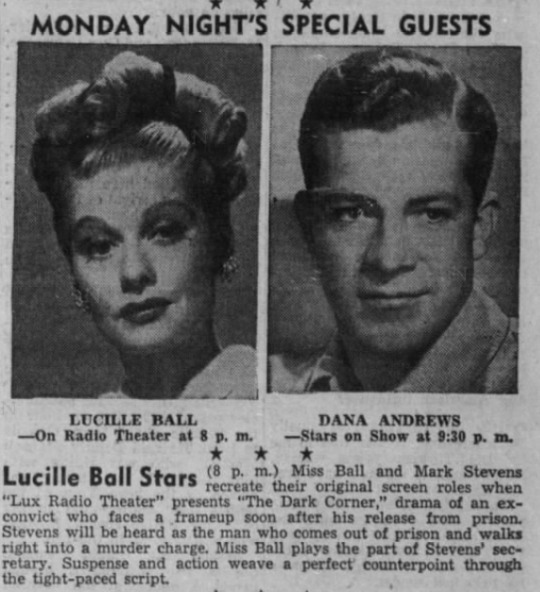
Directed by Fred MacKaye with musical direction by Louis Silvers and sound effects by Charlie Forsyth
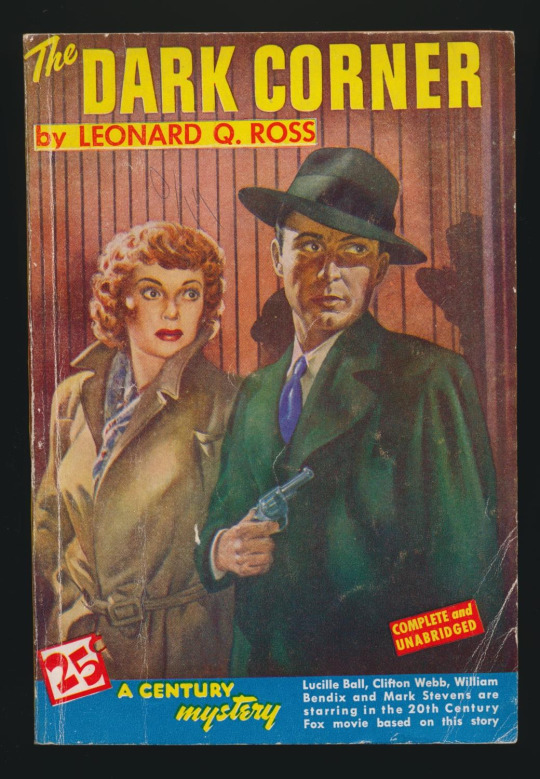
Adapted for radio by Sanford Barnett from the screenplay by Jay Dratler and Bernard Schoenfeld based on the book by Leo Rosten.
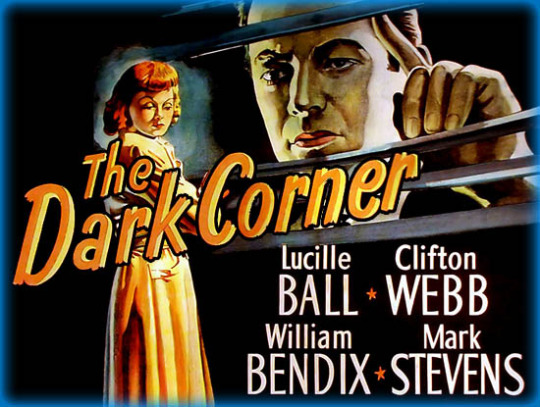
It was based on the 20th Century Fox motion picture of the same name released on May 8, 1946.
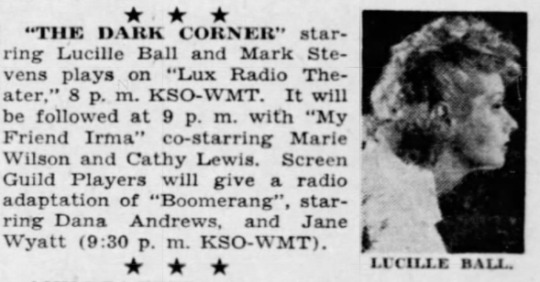
In later years, Lucille Ball was vocal about hating the experience of shooting The Dark Corner. Director Henry Hathaway's bullying reduced Ball to stuttering on set, at which point Hathaway accused her of being inebriated. At the time, Lucille Ball was suing to get out of her contract with MGM. As a result, MGM loaned her to Fox for this picture, which included a significant pay cut.

Lux Radio Theatre (1935-55) was a radio anthology series that adapted Broadway plays during its first two seasons before it began adapting films (”Lux Presents Hollywood”). These hour-long radio programs were performed live before studio audiences in Los Angeles. The series became the most popular dramatic anthology series on radio, broadcast for more than 20 years and continued on television as the Lux Video Theatre through most of the 1950s. The primary sponsor of the show was Unilever through its Lux Soap brand.
CAST

Lucille Ball (Kathleen Stewart) was born on August 6, 1911 in Jamestown, New York. She began her screen career in 1933 and was known in Hollywood as ‘Queen of the B’s’ due to her many appearances in ‘B’ movies. “My Favorite Husband” eventually led to the creation of “I Love Lucy,” a television situation comedy in which she co-starred with her real-life husband, Latin bandleader Desi Arnaz. The program was phenomenally successful, allowing the couple to purchase what was once RKO Studios, re-naming it Desilu. When the show ended in 1960 (in an hour-long format known as “The Lucy-Desi Comedy Hour”) so did Lucy and Desi’s marriage. In 1962, hoping to keep Desilu financially solvent, Lucy returned to the sitcom format with “The Lucy Show,” which lasted six seasons. She followed that with a similar sitcom “Here’s Lucy” co-starring with her real-life children, Lucie and Desi Jr., as well as Gale Gordon, who had joined the cast of “The Lucy Show” during season two. Before her death in 1989, Lucy made one more attempt at a sitcom with “Life With Lucy,” also with Gordon.
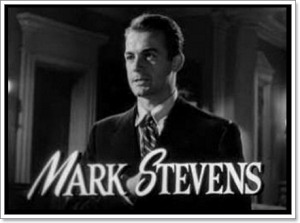
Mark Stevens (Bradford Galt) reprises his role from the film version of The Dark Corner (1946). He became a contract player for Warners at $100 a week in 1943 but they darkened and straightened his curly ginger-colored hair and covered his freckles. At first he was billed as Stephen Richards, he later changed it to Mark Stevens at the suggestion of Darryl F. Zanuck when he switched to 20th Century-Fox. He died in 1994 at age 77.

Joseph Kearns (Ralph Wickett) appeared on “I Love Lucy” as the psychiatrist in “The Kleptomaniac” (ILL S1;E27) and later played the theatre manager in “Lucy’s Night in Town” (S6;E22). His most famous role was as Mr. Wilson on TV’s “Dennis the Menace” (1959). When he passed away during the show’s final season, Lucy regular Gale Gordon took over for him, playing his brother.
In the film, the character was named Hardy Cathcart and was played by Clifton Webb.
Norma Jean Nilsson (Little Girl at the Boarding House) was a child actress who left Hollywood at age 19 after appearing in 16 films and television shows.
In the film, the character carries a slide whistle, which is not used here. She was played by Colleen Alpaugh.
Wally Maher (Fred Foss aka Stauffer) was born on August 4, 1908 in Cincinnati, Ohio. He was known for Mystery Street (1950), The Reformer and the Redhead (1950) and Hollywood Hotel (1937). He was married to Molly Bruno. He died on December 27, 1951.
In the feature film, the role was played by William Bendix, who would go on to fame as the title character in TV’s “The Life of Riley.”
Dan O'Herlihy (Anthony Jardine) was an Irish-born actor nominated for an Oscar in 1954 for Robinson Crusoe. In 1960 he made an appearance on Desilu’s “The Untouchables.” He was in two of the RoboCop movies. He died in 2005 at age 85.
In the feature film, the role was played by German-born actor Kurt Krueger.
Fay Baker (Mari Wickett) was born on January 31, 1917 in New York City as Fanita Baker Schwager. She was known for Notorious (1946), The House on Telegraph Hill (1951) and Deadline - U.S.A. (1952). She died on December 8, 1987.
In the feature film, the role was taken by Cathy Downs, making her first credited screen appearance.
ENSEMBLE
Trude Marson was seen in uncredited roles in four films from 1937 to 1947.
Noreen Gammill started her screen career as the voice of Catty the Elephant in Disney’s Dumbo (1941). She made two background appearances on “The Andy Griffith Show” (1963 and 1964), filmed on the Desilu backlot.
William Johnstone is probably best remembered as Judge Lowell on the long-running daytime drama “As The World Turns”. Prior to that he worked extensively in radio and took over the role of Lamont Cranston on "The Shadow" playing opposite Agnes Moorehead when Orson Welles left the series.
Janet Scott was a regular background voice on “Lux Radio Theatre” with dozens of episodes to her credit from 1937 to 1955.
Lois Corbett was married to Don Wilson of “The Jack Benny Program” and as such did more than a dozen episodes of the television shows with him from 1954 to 1964.
Edward Marr was seen in The Affairs of Annabel with Lucille Ball in 1938. He was also in two Bob Hope TV specials with Hope and Ball in 1966 and 1970.
Stanley Farrar was seen on “I Love Lucy” in “Home Movies” (ILL S3;E20) and “Staten Island Ferry” (ILL S5;E12). He on “The Lucy Show” in “Lucy and Arthur Godfrey” (TLS S3;E23) and “Lucy Meets Danny Kaye” (TLS S3;E15).
Herb Butterfield was born on October 28, 1895 in Providence, Rhode Island. He was known for The Halls of Ivy (1954), The House on Telegraph Hill (1951) and Shield for Murder (1954). On radio, he portrayed the Commissioner on NBC 's "Dangerous Assignment" (1949-53) and Clarence Wellman on "The Halls of Ivy" (1950-52). He died on May 2, 1957
Cliff Clark was seen with Lucille Ball in Her Husband’s Affairs (1947), Miss Grant Takes Richmond (1949), and The Fuller Brush Girl (1950).
OTHERS

William Keighley (Host and Producer) was the director of nearly 40 feature films between 1932 and 1953. His film The Adventures of Robin Hood (1938) was selected for the National Film Registry by the Library of Congress as being culturally significant.
Dorothy Lovett (Commercial Spokeswoman as Libby Collins, Hollywood Reporter) appeared as Meta Bauer on radio’s “The Guiding Light" (1945-47) and as Toni Sherwood in "The Adventures of Rocky Jordan". She did three films with Lucille Ball from 1939 to 1941.
Betty Ann Lynn (Herself, Act Two Intermission Guest) is best known for playing Thelma Lou on “The Andy Griffith Show” (1961 to 1965) which was filmed on the Desilu back lot.
John Milton Kennedy (Announcer) was the announcer of all 35 episodes of “The Loretta Young Show” from 1954 to 1955.
ACT ONE

William Keighley introduces the program, noting that many years earlier, director Fred Kohlmar saw a titian-haired young model who had great possibilities - Lucille Ball. He later had the privilege of presenting her in the film version of The Dark Corner. After a mention of Lux Toilet Soap, the program begins.
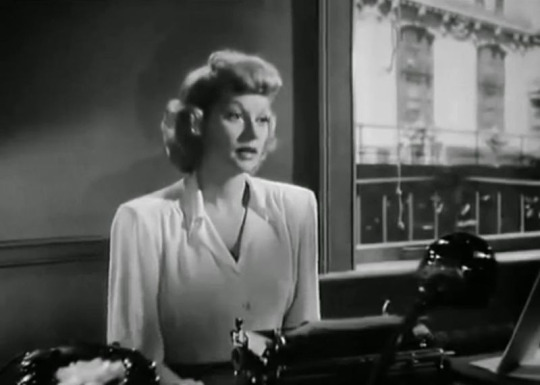
The action opens in a New York City office building on a sultry summer afternoon. Police detective Reeves visits the Offices of Bradford Galt, Private Investigator and speaks to his secretary, Kathleen Stewart.
Galt enters and Reeves wonders why Galt didn’t notify him that he moved offices after his prior unpleasantness. Galt asks Kathleen to have dinner with him. After dinner, Galt asks her to go dancing but she’s wise to his advance. As they walk down the street, they realize that they are being followed.
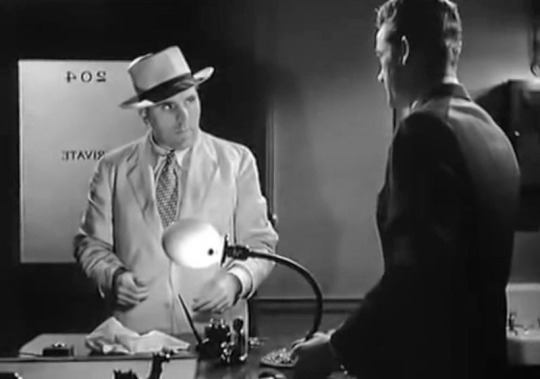
Kathleen takes a cab back to the office, while Galt confronts the pursuer at gunpoint, taking him back to his office for questioning. He says his name is Fred Foss, and that he’s also a private detective. Galt doesn’t believe him and decides to beat the truth out of him.

After some roughing up, Fred discloses that he is being paid to tail Galt by Anthony Jardine. In the tussle, some ink spills on Foss’s white suit. He lets Foss leave. Kathleen was supposed to tail Foss after he left the office, but he tricked her and got away.
Back at his rooming house, Foss uses the hall telephone to call art gallery owner Ralph Wickett, and his ink-stained suit is noticed by a Little Girl neighbor.
At a party for his third wedding anniversary, Wickett hangs up and is greeted by Jardine, a lawyer. Mrs. Lucy Wilding takes Jardine aside pretending to ask legal advice, but it is revealed that he is blackmailing her.
Meanwhile, Galt confides in Kathleen about his past. Jardine is trying to kill Galt because he was a former partner that Galt confronted about his blackmailing female clients. Now Jardine wants to finish the job.
Mari Wickett, Ralph’s wife, is having an affair with Anthony Jardine. She wants to run away with him. At the same time, Galt is headed there to settle the score.
End of Act One

A Lux commercial break takes the form of a story from Libby Collins, Hollywood Reporter. She says she saw Universal’s The Lost Moment starring Robert Cummings and Susan Hayward. Libby says she was on location when they filmed the big fire scene, the biggest fire ever done on a sound stage. She says that she and Susan Hayward washed the soot off their faces with Lux Toilet Soap!
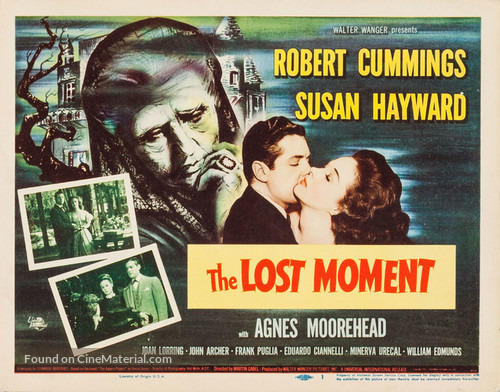
At the time of the broadcast, The Lost Moment was still two weeks from being released. It opened in cinemas on November 27, 1947. The story is set in Italy, so the cast included Edward Ciannelli, who played pizzeria owner Mr. Martinelli in “Visitor from Italy” (ILL S6;E5) and Saverio LoMedico who played the Rome hotel bellboy in “Lucy’s Italian Movie” (ILL S5;E23). The film was not a box office success.
ACT TWO

An hour has past since the end of Act One and Galt is at Jardine’s door. Galt threatens Jardine, who denies tailing him.The two fight while Mari is hiding in the other room. After Galt leaves, she convinces him to run away with her.
At the Gallery, Wickett is visited by Foss. It is clear Wickett is setting up Jardine to take the fall when he has Galt killed. Foss calls Galt to betray Jardine for a price. Galt suggests a one-on-one meeting at his apartment - 904 West 52nd, apartment 307 at 8pm sharp. Wickett will send Jardine to Galt’s apartment at 7:30pm.
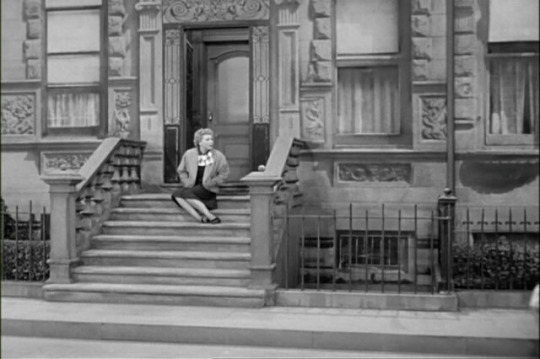
In reality, there is no such address. West 52nd Street in New York City ends at the the 600s block. This is similar to the Ricardo and Mertz apartment building. 623 East 68th Street, which, if real, would be in the East River!
Kathleen and Galt are supposed to meet at the movies, but he doesn’t show so he goes to his apartment at 8:30. Galt opens the door and reveals that Jardine is dead. Galt was ambushed with and knocked out with ether. He woke up to find Jardine’s body bludgeoned by the fireplace poker. Galt realizes he was set up.
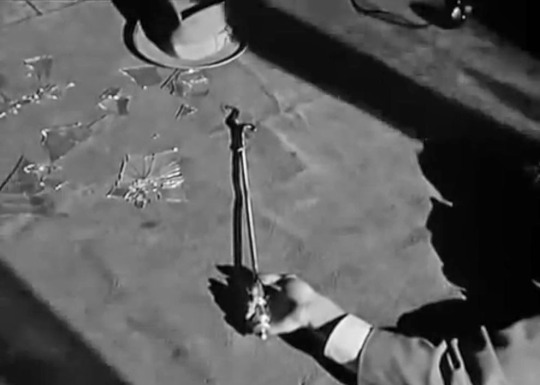
Later, Galt meets Kathleen at her apartment. He couldn’t find Foss and doesn’t know where to look next.
Wickett reminds Mari that they are due at the Kinsglsey’s that night, but she begs off. He strongly hints that he knows that Mari is stepping out on him and looking to run off.
Galt suddenly realizes that Foss would have to have his white suit cleaned, so he is determined to search all the cleaners for the suit and get his address.
Foss phones Wickett, and the Little Girl is there to overhear his conversation. Foss makes a plan to meet Wickett on the 31st floor of the Grant building.
Galt and Kathleen are about to give up on the search for the suit when a cleaner comes through. They get his address and trace Foss to the rooming house where he lives. His name turns out to be Stauffer, not Foss. The landlady reports that he moved out an hour ago and doesn’t know where he went. But the Little Girl does - and spills the beans for a quarter! Galt and Kathleen head for the Grant Building.
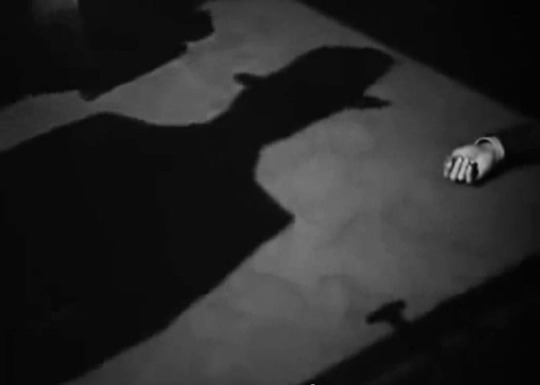
End of Act Two
In the break, Keighley interviews Fox contract player Betty Ann Lynn, who saw filming of Daryl F. Zanuck’s Gentleman’s Agreement starring Gregory Peck and Dorothy McGuire in a “very unusual picture”.

Gentleman’s Agreement premiered on November 11, one day after this broadcast, in both New York City and Chicago. It dealt with anti-Semitism and went on to win three Oscars, including Best Picture. The cast included Lucycom alumni Mike Lally, Shep Houghton, Roy Roberts, and Amzie Strickland in uncredited roles. Betty Ann Lynn says that she also likes to watch the filming of a costume picture like The Foxes of Harrow starring Rex Harrison and Maureen O’Hara, who had 26 costumes made just for her. She notes that O’Hara has a Lux complexion.
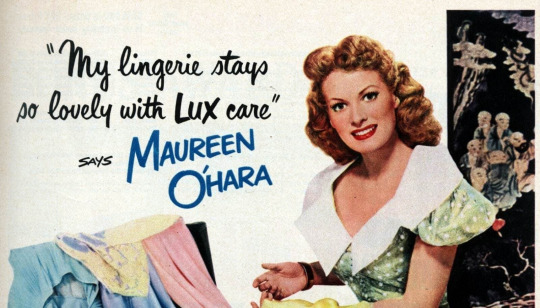
The Foxes of Harrow was released September 13, 1947. "Lux Radio Theater" broadcast a sixty minute radio adaptation of this movie on December 6, 1948, with Maureen O'Hara reprising her movie role. The movie was the screen debut of William Schallert, who did several episodes of “The Lucy Show.” O’Hara and Lucille Ball became lifelong friends after their 1940 film Dance, Girl, Dance. Like Gentleman’s Agreement, The Foxes of Harrow also features Roy Roberts, who went on to play bank president Mr. Cheever on “The Lucy Show.”
ACT THREE
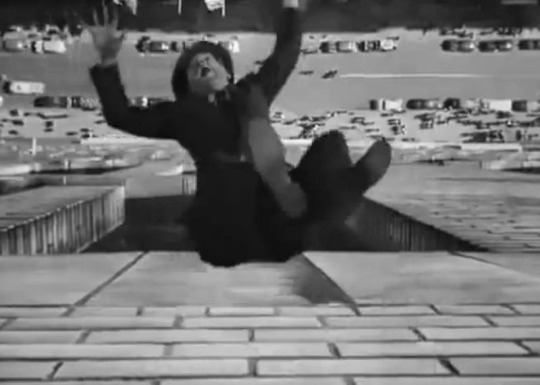
Kathleen and Galt rush to the Grant Building, where Mr. Wickett is about to settle accounts on a remote fire escape. Foss / Stauffer brings proof that Jardine is dead but Wickett throws him from the fire escape to his death.
Galt and Kathleen witness the whole incident from the street, as does the cab driver who was waiting for Foss / Stauffer. Thinking fast, Galt steals the cab which still contains Foss’s luggage. Later, we hear that the bags were only full of clothes. Kathleen urges him to keep thinking. Kathleen suddenly remembers that the Little Girl mentioned galleries. They put the pieces together and all evidence leads them to the Wickett Galleries. Galt heads there and questions the clerk. Under the guise of buying a painting, Galt inquires about meeting Mr. Wickett, and the clerk departs. Mari comes in the side door, and Galt tells her that Anthony Jardine has been murdered. She faints. Wickett comes in and when Galt tells him the truth, Ralph locks him in the gallery vault. Mari has revived and overhears Ralph’s threats, holding a gun on him. She shoots her husband dead.
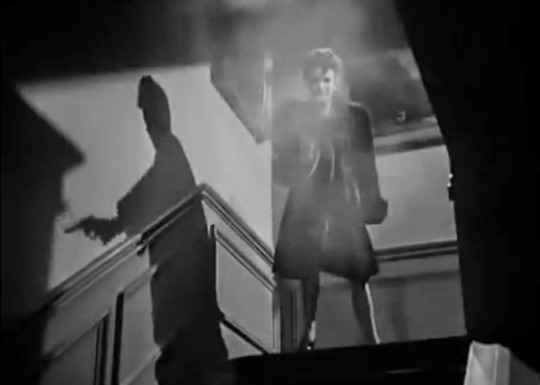
Kathleen has tipped off the police, who only want to charge him with stealing a taxi cab. Kathleen asks if he can be booked at another time because they have a date at the City Hall - to get married.
End of Story
As a curtain call, Keighley chats with Lucille Ball and Mark Stevens. He congratulates Ball on the success of her stage show, Dream Girl, a play she says she will do again in San Francisco. When Keighley asks how Lucille’s busy schedule and that of her husband Desi Arnaz’s leave any time for a personal life, Ball says that they will be playing in San Francisco at the same time.

In June 1947, Lucille Ball performed at New Jersey’s McCarter Theatre in Dream Girl, a play by Elmer Rice. It also played Brooklyn, Detroit and Boston.

The San Francisco production opened just a week after this radio telecast. As Ball states, Desi Arnaz was also in San Francisco at the time, playing in the Rose Room of the Palace Hotel, a fact that was advertised in the Dream Girl program. During the Los Angeles engagement in January 1948, Ball fell ill and had to withdraw. Although she love performing on stage, her radio career and then television success did not allow her to return to the footlights until 1960.

Lucy notes that like many other busy stars, she owes her good complexion to Lux Soap!
Turning to Mark Stevens, Lucille notes that he will play an FBI man in his next project at Fox, with Keighley as director.
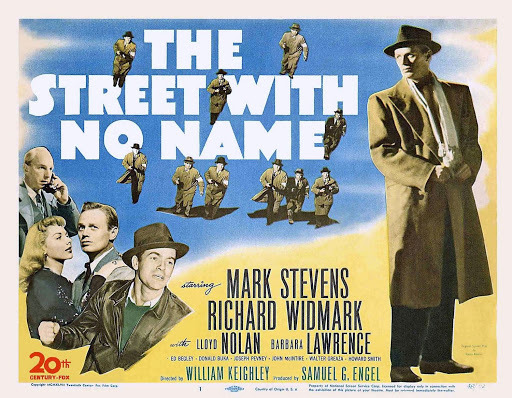
Although the film’s title is not mentioned, they are referring to The Street With No Name, which won’t be released until June 1948. Stevens plays Gene Cordell aka George Manley, a covert FBI agent who infiltrates a ruthless gangster mob. "Lux Radio Theater" broadcast a 60-minute radio adaptation of the movie on January 31, 1949 with Mark Stevens reprising his film role.
Keighley notes that next week “Lux Radio Theatre” will present Jane Wyman and Ronald Reagan in Nobody Lives Forever.

The Warner Brothers picture Nobody Lives Forever was released on November 1, 1946. It originally starred John Garfield and Geraldine Fitzgerald in roles taken on radio by Reagan and Wyman, who were husband and wife at the time. Of course, Reagan left Hollywood for a grander stage, first in California as Governor, then as President of the United States. He bestowed Lucille Ball with The Kennedy Center Honor in 1986.
A public service announcement asks housewives to salvage kitchen fats and turn them in at their local butcher for cash!
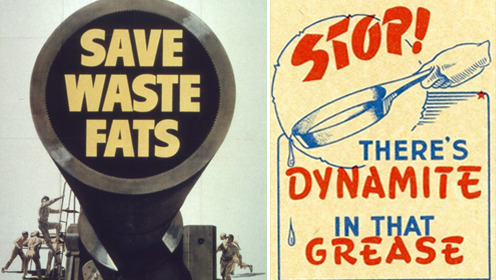
These were used to make supplies for wartime, such as ammunition and weapons.
Announcer Kennedy notes that Mark Stevens appeared through the courtesy of 20th Century Fox, producers of Forever Amber.

Forever Amber is a 1944 romance novel by Kathleen Winsor set in 17th-century England. It was made into a film in 1947 starring Cornel Wilde, who appeared in “The Star Upstairs” (ILL S4;E25). When “Lucy Writes A Novel” (ILL S3;E24), Ethel jokes about finding Lucy’s hidden manuscript and burning it: “We pulled down the kitchen blind and changed the name of your novel to 'Forever Ember.'”
‘DARK’ TRIVIA

In a September 1985 episode of “Remington Steele,” a character played by Stephen Dillane has the name Bradford Galt! The stories, however, are not otherwise connected.
In both the film and the radio show, Fred Foss gives his phone number as CH-elsea 4-43510. However, according to the Manhattan phone book for 1946, there were only CH-elsea 2 and CH-elsea 3 exchanges. Real phone numbers were rarely used in film or television.

When television began to supplant radio, “The Lux Video Theatre” was introduced. It was seen from 1950 to 1959. Initially, the show was a thirty-minute weekly show featuring live stage plays, but when it moved to NBC in August 1954, the show was extended to sixty minutes. As on radio, the programs were then primarily adaptations of motion pictures. The host would introduce each act, and would conduct an interview with the stars at the end of the play. Of the cast of this radio version of The Dark Corner:
William Keighley directed an episode in 1951.
Mark Stevens did an episode in 1955.
Dan O’Herlihy did five episodes.
Joseph Kearns did three episodes.
The character name Ralph Wickett replaced Hardy Cathcart for the radio show. It is likely that they could no longer get legal clearance to use the name Hardy Cathcart, necessitating the change.
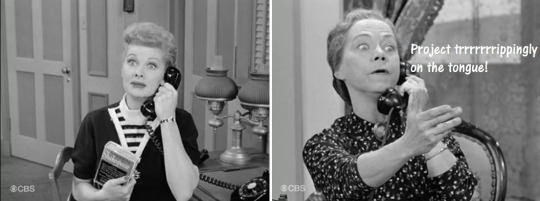
The film featured Ellen Corby as a maid, a role not in the radio drama. Corby went on to be seen as Lucy Ricardo’s high school acting teacher and in several small roles on “The Lucy Show” before her best-loved role of Grandma on “The Waltons.”

The film also features background work by Sam Harris, who did 15 films with Lucille Ball, in addition to multiple episodes of “I Love Lucy” and “The Lucy Show” as well as Harold Miller, who did eight films with Lucy and two episodes of “I Love Lucy”.

The film is available on DVD complete with DVD commentary and original trailer.

#The Dark Corner#Lucille Ball#Mark Stevens#Lux Radio Theatre#Radio#1948#Joseph Kearns#William Keighley#1947
8 notes
·
View notes
Photo
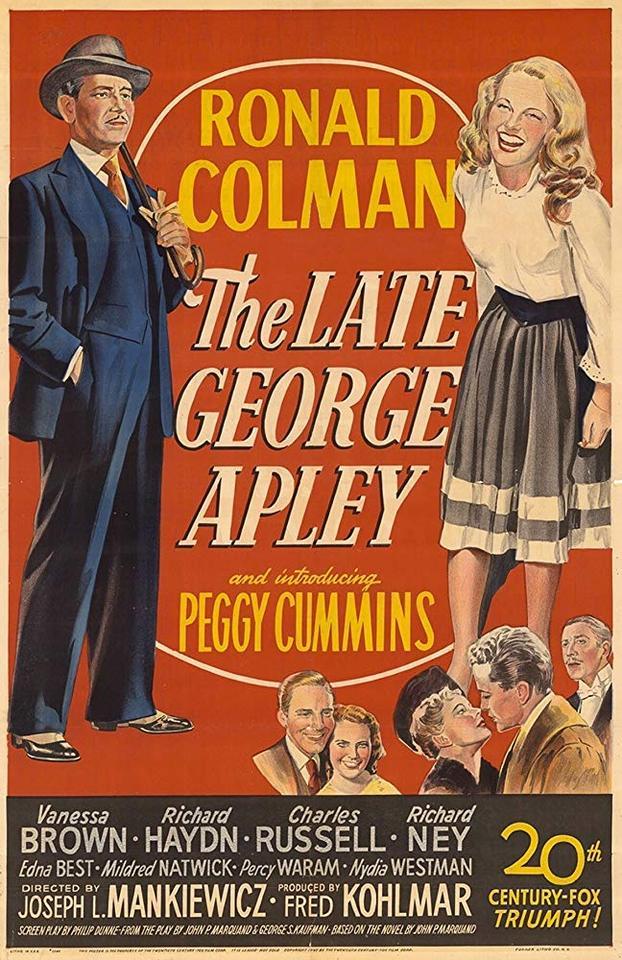
The Late George Apley (1947)
by Joseph L. Mankiewicz
Comedia - 93 mn - United States of America


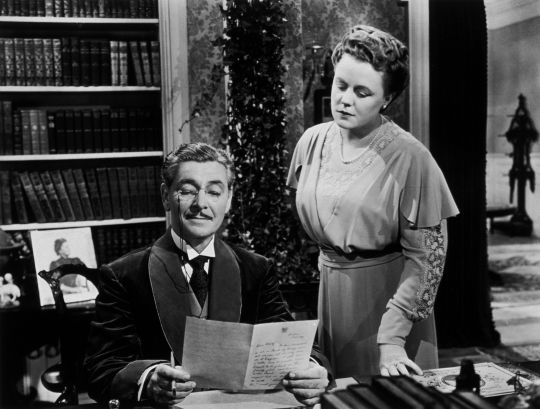
#1947#40s#fred kohlmar#joseph lashelle#cyril j. mockridge#philip dunne#George S. Kaufman#john p. marquand#comedy#ronald colman#peggy cummins#vanessa brown#mildred natwick#USA#nydia westman
1 note
·
View note
Photo

Choreographer Hermes Pan, Frank Sinatra, Rita Hayworth with her daugter Yasmin and producer Fred Kohlmar on the set of Pal Joey, 1957
#hermes pan#frank sinatra#rita hayworth#yasmin aga khan#fred kohlmar#on the set#pal joey#1957#50s#edits
107 notes
·
View notes
Photo

Classic Hollywood Birthdays Hugh Herbert, actor & comedian (1884-1952) Sam Warner, producer & studio mogul (1887-1927) Henry O’Neill, actor (1891-1961)
#Alan Crosland#Brian Easdale#Curt Siodmak#Eddie Fisher#Fred Kohlmar#Henry O’Neill#Hugh Herbert#Jack Haley#Ken Annakin#Martha Hyer#Martin Benson#Noah Beery Jr.#Norma Shearer#Rhonda Fleming#Sam Warner#Walter Lang
5 notes
·
View notes
Photo

Director George Sidney, Rita Hayworth, Frank Sinatra and Fred Kohlmar on the set of Pal Joey - 1957
10 notes
·
View notes
Photo

George Sidney (Director), Rita Hayworth, Frank Sinatra and Fred Kohlmar photographed on the set of Pal Joey.
57 notes
·
View notes
Photo

Classic Hollywood Birthdays
Rhonda Fleming, actress (1923- ) See Rhonda Fleming in Spellbound(1945) on August 15th as part of…
View Post
#Brian Easdale#Curt Siodmak#Eddie Fisher#Fred Kohlmar#Gregory Peck#Jack Haley#Ken Annakin#Martha Hyer#Noah Beery Jr.#Norma Shearer#Rhonda Fleming#Sam Warner#Spellbound#TCM#TCM Summer Under the Stars#Turner Classic Movies#Walter Lang
2 notes
·
View notes